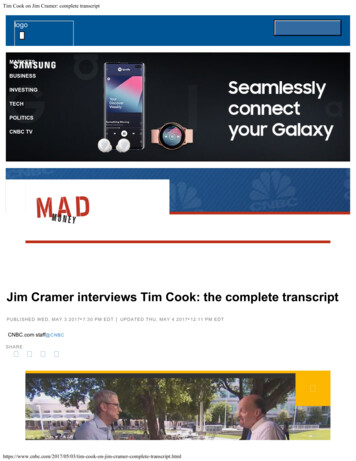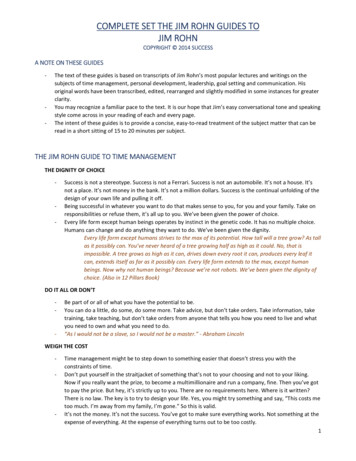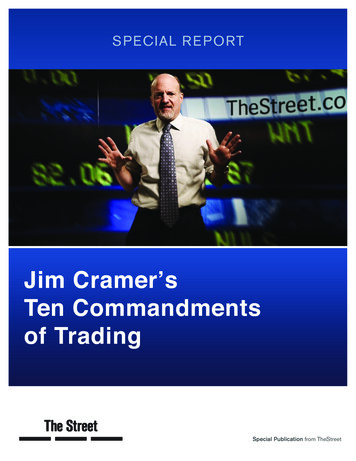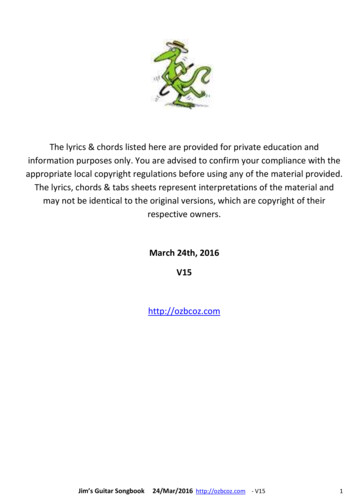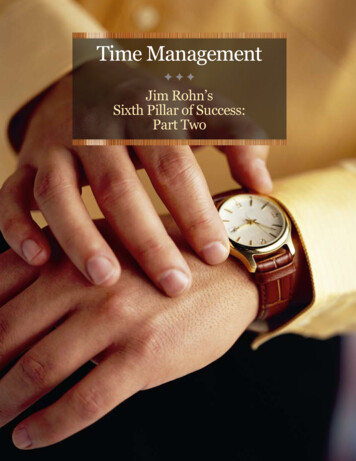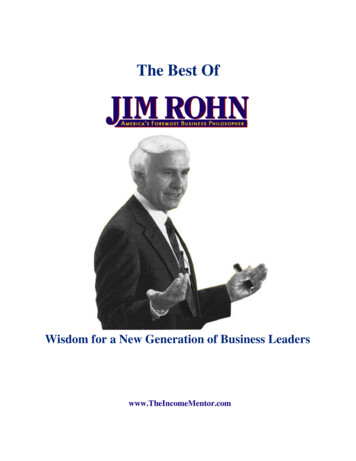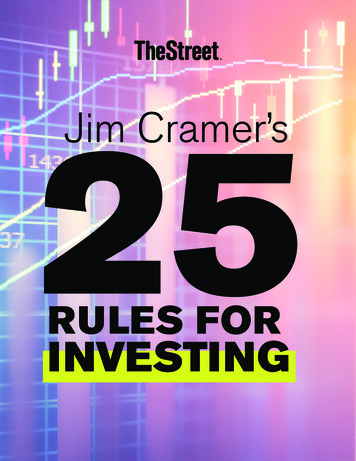
Transcription
25Jim Cramer’sRULES FORINVESTING
Jim Cramer’sRule No.125RULES FOR INVESTING Bulls Make Money, Bears Make Money, Pigs Get SlaughteredSo many times in my almost 40 years on Wall Street, I’ve seen moments where stocks went up so much thatyou were intoxicated with gains. It is precisely at that point of intoxication, though, that you need to remindyourself of an old Wall Street saying: “Bulls make money, bears make money, but pigs get slaughtered.”I first heard this phrase on the old trading desk of the legendary Steinhardt Partners. I would be having abig run in some stock (or the market entirely) and Michael Steinhardt would tell me that I had made a lot ofmoney — perhaps too much money — and maybe I was being a pig. I had no idea what he was talking about.I was so grateful that unlike so many others, I had stayed in and caught some very big gains.Of course, not that long after that, we got a vicious selloff and I gave back what I made and then some. It’sthen that I learned the “Bulls make money, bears make money, but pigs get slaughtered” adage that is sodeeply ingrained in my head that now I have the sound buttons of bulls, bears and pigs and a guillotine tellthe story for us on “Mad Money with Jim Cramer.”Just so you know, the same thesis applies to those who press their bets on the short side. We’ve had somemajor corrections of stocks over the years, but other than in 2000 and then again in 2007-2009, moststocks bounced back after their declines. If you stayed short you were a pig, too, and you got slaughtered.So often when I bring this adage up, people ask me, “How do you know when you are being a pig?”I know there’s not supposed to be any stupid questions out there, but the answer is, frankly, you don’t needme to tell you.If you weren’t feeling piggish after we hit an all-time high on the Nasdaq in 2000 after a 3,000-point jauntin almost no time flat, you needed a shrink, pronto. We all know how that ended (and how long it took to getback to that vaunted level). If you were walking around owning a huge amount of stock in 2008 as bankafter bank failed, you, too, were a pig.Remember, one of my chief goals is to stay in the game. The people who got wiped out by the Nasdaq crashtended to be people who never took anything off the table, who never felt greedy; they were slaughtered bytheir own piggishness. Same with those who never came back from the 2007-2009 charnel house.But it was my desire not to be a pig that kept me in the game both at the time of the Nasdaq crash and thebig downturn that bottomed in the spring of 2009. That’s why I remind people every day, “Have you takenyour profit? Have you booked anything? Or are you being a pig?”Because you never know when things you own are going to crash. You never know when the market couldbe wiped out. You can’t have certainty. At those times, you have only human nature to guide you.Sure, there will be times when stocks just keep going and going and going. When I coined the term FANGa few years back for Facebook, Amazon, Netflix and Google (which became Alphabet), I loved them all. ButI gave up on Amazon after an amazing run. It continued to move up another 50%. I felt like a pig after thatextremely profitable run, and I felt like a fool when it kept on galloping.It’s just the price I have to pay for following my adage. I recognize for every huge pile of cash left on the tablein an Amazon, there’s the gigantic losses that could have occurred had I stayed in the casino in 2000 and in2008 — the two experiences that destroyed not one but two generations of investors.LEAR N M OR E AB OUT ACTI ON ALE RTS PLU S
Jim Cramer’s25RULES FOR INVESTINGI think you could say that my desire not to be too greedy saved me so I could live to play again. So, neverforget: “Bulls make money, bears make money, but pigs get slaughtered.” If you do, I will be sure to remindyou — soon — with my sound board on “Mad Money. “Rule No. 2It’s OK to Pay the TaxesNo one has ever liked to pay taxes. As long as there have been taxes, people have hated paying them. Butthe aversion to paying taxes on stock gains borders on the pathological. That’s why my second bedrock tenetfor my 25 Rules for Investing is, “It’s OK to pay the taxes.”So many times, people will have gigantic gains and they simply refuse to take any profits because they don’twant to incur taxes that cut into their winnings. But Wall Street is littered with the broken hearts of peoplewho feel like this.A couple of years ago, for example, I went to a presentation from a prominent hedge-fund manager whorecommended buying Macy’s stock because of its real estate value. The stock had already run a great dealand was ripe for some profit-taking. But I know people who had owned it for years and had hefty profits anddidn’t want to take them because they would have to write a check to Uncle Sam.Next thing you know, the stock of Macy’s was cut in half — and it wasn’t any 2-for-1 split. Rather, shoppingmalls had hit a tipping point courtesy of Amazon, and that was all she wrote. Those who didn’t want to sharethe profit with Uncle Sam got no profit at all.I had zero sympathy for the people who held on to the stock. I have long ago made my peace with theTax Man. I know that some gains were and are simply unsustainable. Given, though, that so many peoplethought that if you bought and held, you always ended up with more than if you bought and sold, mydiscussion fell on deaf ears — an audience like Gollum, the character in The Lord of the Rings who says,“I’m not listening, I’m not listening.”It’s important to remember that gains — any gains — can be ephemeral. It is better to stop worrying about theTax Man and take the gains when they appear unsustainable than to ride things back to a loss. Stop fearingthe Tax Man; start fearing the Loss Man. You won’t regret it.Rule No. 3Don’t Buy All at OnceNo broker likes to fool around with partial orders. No financial adviser has the time to buy stocksmethodically over time. The game is to get the trade on, at one level, in a big way. Make the “statement buy.”Get the position on the sheets or in the portfolio.But from where I sit, that’s all wrong — 100% wrong. Never buy all at once. Never sell all at once, either.Instead, stage your buys. Work your orders. Try to get the best price over time.LEAR N M OR E AB OUT ACTI ON ALE RTS PLU S
Jim Cramer’s25RULES FOR INVESTINGWhen I first started out as a professional trader, I wanted to prove to everyone how big I was and how right Iwould be. If I wanted to buy Caterpillar, then by golly I wanted to buy it now — big, at one price — because Iwas so sure of how right I was. “Put me up on 50,000 CAT!” I would scream, as if I were the smartest guy inthe universe.But what an arrogant son of a gun I was. Arrogant and wrong.What should I have been doing? Following my rule that you don’t buy all at once. If I wanted to get 50,000CAT in, I would buy it in units of 5,000 over time, trying to get the best price. I would put some on to start andthen hope to work my way down to get a better basis.Now, I no longer trade institutionally, and I no longer trade “in size.” But I still invest for my Action Alerts PLUScharitable portfolio, and when I have a new name, I buy in 500-share increments over the course of a day toget my several-thousand-share position on. I do it that way to give me a terrific price.Why don’t more people do it my way? Why don’t people who want 500 shares of ExxonMobil buy it in100-share increments? I think it’s because they want to be big, too. They don’t want to waste their broker’stime, and the broker wants to get the trade done. I know my brokers hated it when we would place ordersfrom my old hedge-fund desk.Nevertheless, it’s just plain hubris to buy a big chunk of anything (relative to your net worth) all at once.Who knows if the stock will crater soon after?You must resist feeling like you are making a “statement” with your purchase. I’ve bought and sold billions ofshares of stock. Do you know how often I got in at the right price? Do you know how often the last price Ipaid was the lowest and it was off to the races? Probably one in 100, and I’m pretty good at this game.Resist the arrogance, buy slowly, even buy over a couple of days as I do for my Action Alerts PLUS portfolio.It’s humbling and it’s right.Rule No. 4Buy Damaged Stocks, Not Damaged CompaniesLet’s say Wall Street was holding a sale on merchandise that it had to move. And let’s say you took thatmerchandise home only to find it didn’t work, had a hole in it or was missing a key part. If we were onMain Street, it wouldn’t matter. There are guarantees and warranties galore on Main Street. You can takeanything back.But you can’t return merchandise on Wall Street and get your money back. Nope, no way. Which is why Ialways say, “Buy damaged stocks, not damaged companies.”Sometimes these buys are easy to discern. In 1998, when Cendant was defrauded by the management ofCUC International through a series of bogus financials, the stock went from 36 to 12 in pretty much astraight line.Was that a one-day sale that should be bought? No, that was a damaged company. It took years for Cendantto work its way back into investors’ hearts. Some say it has never recovered.LEAR N M OR E AB OUT ACTI ON ALE RTS PLU S
Jim Cramer’s25RULES FOR INVESTINGIf you have any doubt what damaged merchandise is, I urge you to buy a copy of my autobiography,“Confessions of a Street Addict.” The Cendant story is all there for those to see, including former New Jerseygovernor Chris Christie—who soon after the book came out had me testify against an officer of the companywho was instrumental in the fraud. There was no merchandise worth owning in much of that company.But sometimes the sales on Wall Street aren’t as obvious. I got snookered in 2004 into thinking thatNortel’s accounting problems were a simple selloff of a damaged stock, with the company actually quitewhole. But in fact, the company was gravely damaged by accounting fraud and it looked doubtful that itwould ever recover.And sometimes the sale is so steep that it looks as if something’s dreadfully wrong, but the problem is reallysomething that will go away over the longer term.The same thing happened with some of the oils that my charitable trust owned in 2016. I figured there wasno way a stock like Marathon Oil could be cut in half without bouncing back — but I was wrong. It got cutalmost in half again and has barely recovered because in the end, it was just a mirror of a commodity thathasn’t been able to recover.How do we know if there’s something wrong with the company instead of just the stock? I think that’s toocomplicated a question.What I like to do is develop a list of stocks I like very much. I call this the “bullpen” at my Action Alerts PLUSclub for investors, and when Wall Street holds an en masse sale on a bullpen stock, I like to step up to theplate and buy.I particularly like to be ready when we have multiple selloffs in the stock market because of events unrelatedto the names that I want to buy. I like a major shortfall of an important bellwether stock, or perhaps somemacro-event that doesn’t affect my micro-driven story.Of course, sometimes you just have to deduce that a company’s fortunes haven’t really changed and thatthe fundamentals that triggered a selloff (either in the market or the company) will reverse shortly. But younever know — which, again, is why I think you must obey Rule No. 3: “Don’t Buy All at Once.” If you don’t buyall the stock at once but instead take your time, it’s more likely that you won’t be left holding a huge chunk ofmerchandise when more bad news comes around the corner.Rule No. 5Diversify to Control RiskIf you control the downside, the upside will take care of itself. I have always believed that to be the case, butcontrolling the downside means managing the risk.The biggest risk out there is sector risk. I don’t care how great a tech stock was in 2000 (even an eBay or aYahoo!) if you had all of your eggs in that sector, you got scrambled. Same with the financials in 2008 or oilfrom 2014 to 2016.What can keep you from getting nailed by sector risk, which is about 50% of the entire risk of owning astock? Answer: Diversification.LEAR N M OR E AB OUT ACTI ON ALE RTS PLU S
Jim Cramer’s25RULES FOR INVESTINGThat’s the only investment concept that truly works for everyone. If you can mix enough different sectors intoyour portfolio, you can’t be hit by one of the myriad perfect storms that come our way far more often than youwould think.Why aren’t more people diversified? Well, many amateurs don’t know the stocks they buy. They end up withstocks that are frighteningly similar. When I started playing “Am I Diversified?” on my radio show in 2001, Iwas blown away by how few people knew just how undiversified they really were.I still field quite a few calls from people who genuinely think that owning the FANG stocks is a diversifiedstrategy. Hardly. You own variations of the same thing — social, mobile and the cloud — and they movetogether. That’s faux diversification.No matter how much I may like oil stocks at any given moment, I can’t countenance a portfolio made up ofExxonMobil, Chesapeake Energy and Halliburton. I will always say no to a portfolio of Johnson & Johnson,Eli Lilly, Allergan and United Health, even if I like all four. They just leave you exposed to health-care sectorrisk that could overwhelm any of these stocks.Having an undiversified portfolio is not just an amateur mistake, though. Many professionals don’t like to bediversified because of the bizarre way money is run in this country.If you concentrate all your bets in one sector and the sector takes off, you will beat pretty much everydiversified fund out there. That’s the nature of the beast. You then can market yourself as a huge successand get profiled by every magazine and take in capital from unsuspecting folk who don’t know how much riskyou’re truly taking on.Bu
Jim Cramer’s 25 RULES FOR INVESTING LEARN MORE ABOUT ACTION ALERTS PLUS I think you could say that my desire not to be too greedy saved me so I could live to play again.
